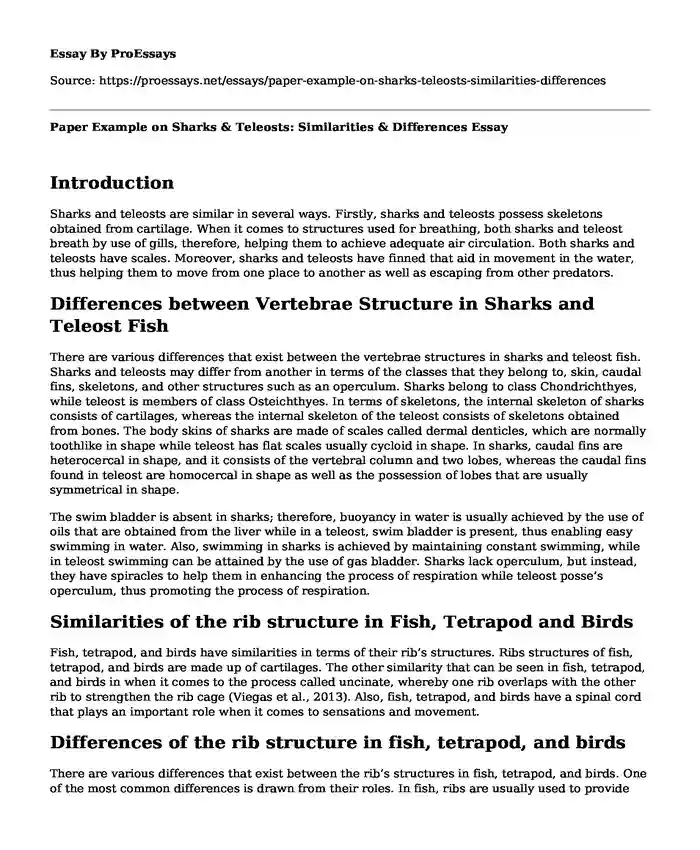Introduction
Sharks and teleosts are similar in several ways. Firstly, sharks and teleosts possess skeletons obtained from cartilage. When it comes to structures used for breathing, both sharks and teleost breath by use of gills, therefore, helping them to achieve adequate air circulation. Both sharks and teleosts have scales. Moreover, sharks and teleosts have finned that aid in movement in the water, thus helping them to move from one place to another as well as escaping from other predators.
Differences between Vertebrae Structure in Sharks and Teleost Fish
There are various differences that exist between the vertebrae structures in sharks and teleost fish. Sharks and teleosts may differ from another in terms of the classes that they belong to, skin, caudal fins, skeletons, and other structures such as an operculum. Sharks belong to class Chondrichthyes, while teleost is members of class Osteichthyes. In terms of skeletons, the internal skeleton of sharks consists of cartilages, whereas the internal skeleton of the teleost consists of skeletons obtained from bones. The body skins of sharks are made of scales called dermal denticles, which are normally toothlike in shape while teleost has flat scales usually cycloid in shape. In sharks, caudal fins are heterocercal in shape, and it consists of the vertebral column and two lobes, whereas the caudal fins found in teleost are homocercal in shape as well as the possession of lobes that are usually symmetrical in shape.
The swim bladder is absent in sharks; therefore, buoyancy in water is usually achieved by the use of oils that are obtained from the liver while in a teleost, swim bladder is present, thus enabling easy swimming in water. Also, swimming in sharks is achieved by maintaining constant swimming, while in teleost swimming can be attained by the use of gas bladder. Sharks lack operculum, but instead, they have spiracles to help them in enhancing the process of respiration while teleost posse’s operculum, thus promoting the process of respiration.
Similarities of the rib structure in Fish, Tetrapod and Birds
Fish, tetrapod, and birds have similarities in terms of their rib’s structures. Ribs structures of fish, tetrapod, and birds are made up of cartilages. The other similarity that can be seen in fish, tetrapod, and birds in when it comes to the process called uncinate, whereby one rib overlaps with the other rib to strengthen the rib cage (Viegas et al., 2013). Also, fish, tetrapod, and birds have a spinal cord that plays an important role when it comes to sensations and movement.
Differences of the rib structure in fish, tetrapod, and birds
There are various differences that exist between the rib’s structures in fish, tetrapod, and birds. One of the most common differences is drawn from their roles. In fish, ribs are usually used to provide the protection of the internal organs while in tetrapod ribs serve two major roles; protection of the lungs and the heart. When it comes to birds’ ribs are normally used to attach flight muscles and in the attachment of lungs. Also, fish, tetrapod, and birds differ from one another in terms of ribs used for breathing. Fish uses ribs structures called gills while breathing while tetrapod breath by using ribs attached to the lungs. Birds use air sacs found in the lungs for breathing (Mayr, 2016).
Provide some discussion points on how these differences accommodate for different body structures
The difference that exists between the rib’s structures in fish, tetrapod, and birds usually accommodate for different body structures because they play a critical role in promoting the process of gaseous exchange. Also, ribs structures help in the attachment of skeleton muscles that help in supporting of other body organs.
References
Mayr, G. (2016). Avian evolution: the fossil record of birds and its paleobiological significance. John Wiley & Sons.
Viegas, C. S., Simes, D. C., Williamson, M. K., Cavaco, S., Laizé, V., Price, P. A., & Cancela, M. L. (2013). Sturgeon Osteocalcin Shares Structural Features with Matrix Gla Protein EVOLUTIONARY RELATIONSHIP AND FUNCTIONAL IMPLICATIONS. Journal of Biological Chemistry, 288(39), 27801-27811.
Cite this page
Paper Example on Sharks & Teleosts: Similarities & Differences. (2023, Oct 02). Retrieved from https://proessays.net/essays/paper-example-on-sharks-teleosts-similarities-differences
If you are the original author of this essay and no longer wish to have it published on the ProEssays website, please click below to request its removal:
- Paper Example on Banning Horse-Drawn Carriages From the Street of New York City
- Remaking Nature Essay Example
- Essay Sample on Atrioventricular and Semilunar Valves
- Essay Sample on Digestive and Respiratory System
- Essay Sample on Ergot Theory
- Nature vs. Nurture: Unveiling the Impact of Genes on Intelligence - Annotated Bibliography
- Report Example on Management of Stormwater







